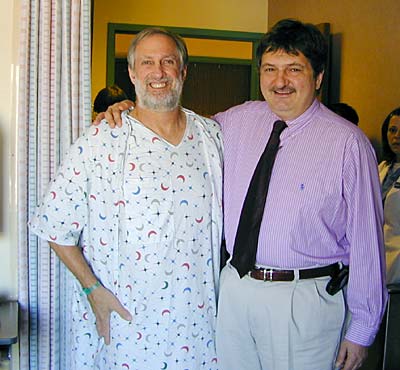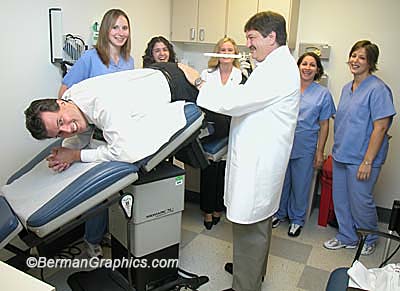|
| |
 |
|
|
|
|
|
A
Colonoscopy Saved My Life |
|
Nov, 16, 2023 - another normal colonoscopy
I should have gone last year but I was having ankle surgery.
|
| 2018 - another normal colonoscopy |
|
Mar 14th, 2014
another normal colonoscopy
I got nervous when a tumor was found during a colonoscopy of a close relative, so I went a year earlier |
May 24th, 2012
another normal colonoscopy
Ten years cancer free and I was told I wouldn't need another
colonoscopy for three years |
July 2010
another normal colonoscopy |
Feb 16, 2009
Six 1/2 year update - another normal colonoscopy |
Nov 8, 2006
Four year update - another normal colonoscopy |
Oct 25th, 2004
Two year update -I had my two year colonoscopy this morning and it
showed no signs of cancer. |
| Sept 20, 2002 - colon cancer
surgery |
Posting to the forums I participate in
Back in 2002, I posted about my colon cancer and how the colonoscopy saved
my life because my cancer was discovered in time to be completely cured
through
laparoscopic surgery.
I had a number of people getting a colonoscopy and even had two people
thank me because it was discovered that they had a tumor but it was early
enough for it to be removed without effecting their health. |
Overview
An intermittent stomach pain led me to getting a
colonoscopy where a lemon sized malignant mass was found in my colon and
successfully removed surgically. My surgeon felt that based on its size,
it had been growing for two to four years. Still enough time for it to be
safely
removed and that I won’t need any further treatment. A colonoscopy is
recommended every two years for people between the ages 50 and 80. I’m 53
and have been in an avoidance mode, but now I’ve changed my way of
thinking because it saved my life. |
|

Larry with Dr. Philip Caushaj
West Penn Hospital, Pittsburgh PA
Sept 24, 2002 |
| History |
 |
July 28, 2002 –
at 53 years old - I don’t know why I remember the exact
date but I started having an intermittent stomach pain that led me
to believe I was getting an ulcer. It was a cramping pain that only
lasted about 5 to 7 seconds occasionally throughout the day. |
 |
August 15th – Contacted Morgan Flaherty, my
family doctor, and he scheduled me for a series of tests and set up
an appointment for me with Dr. Mahesh Varindani for an endoscopy
examination. |
 |
Sept 10 – Appointment with Dr. Flaherty and had
blood drawn. |
 |
Sept 11 – Dr Verindani performed an endoscopy
examination, from which the results were negative. He then scheduled
me for a colonoscopy examination on Sept 18. |
 |
Sept 18 – The colonoscopy showed a lemon sized
mass in my large intestine and even though he preformed a biopsy, he
had me admitted and brought in Dr. Philip Caushaj to remove it. I
underwent an abdominal CT scan and EKG and more blood work.
|
 |
Sept 19 – Met with Dr. Caushaj and his staff when
they explained the procedure to me. |
 |
Sept 20 – 8:00AM surgery performed
laparoscopically
to remove the mass. |
 |
Sept 22 – went on clear liquid diet. |
 |
Sept 23 – went on normal diet. |
 |
Sept 24 – discussed the results of the biopsy and
discharged. |
 |
Oct 30- Saw Dr. Jane Raymond, the Oncologist, and
was given a clean bill of health. |
 |
Oct 1, 2003 - I had my first annual
colonoscopy today and the results were negative. This was the one
I was worrying about as it’s been a year since my colon cancer was
diagnosed and successfully treated through surgery. |
 |
Sept 25, 2004 - mentally preparing for my
second year colonoscopy in about two weeks. |
 |
Oct 25, 2004 - I had my colonoscopy this
morning and I passed with flying colors. My doctor told me that I
can wait two years for my next one. Yea..... |
|
Colonoscopy
A colonoscopy is a procedure of viewing the interior lining
of the large intestine (colon) using a colonoscope, a flexible fiber-optic
tube. |
Colon Cancer
The colon and rectum are part of the large intestine
(bowel). Colon and rectum cancers, which are sometimes referred to
together as "colorectal cancer", usually grow in the lining of the large
intestine. (When cancer grows in the lining of an organ like the large
intestine, it is called a carcinoma.) Other types of colon cancer are
rare, and include lymphoma, carcinoid, melanoma, fibrosarcoma, and other
types of sarcoma. There are 3 basic tests for colon cancer: a stool test
to check for blood; sigmoidoscopy: inspection of the lower colon; and
colonoscopy: inspection of the entire colon. All 3 are effective in
catching cancers in the early stages, when treatment is most beneficial.
|
The Biopsy
The fact that it was malignant wasn’t as much of an issue
as how far it had spread. The CT scan was normal. The mass was labeled as
a Type B1. Type A is 98% curable with surgery and type B1 is 92% curable
through surgery. The outcome is that I have to be monitored for the next
ten years but no further treatment is necessary. No chemotherapy and no
radiation. I have to see my surgeon at regular intervals and have a
colonoscopy each year for the next five years. A small price to pay for
living a normal life. The fact that it was the size of a lemon, according
to Dr. Caushaj, meant that it had only been there for two to four years. A
relatively short time in the life of a mass in the colon. Normally a mass
in the intestines isn’t detected until it becomes large enough to cause a
blockage. |
| I was advised by Dr. Caushaj to notify all
my immediate family including first cousins to be tested, as it's
considered a genetic defect. |
|

Dr Caushaj with Dr Read and staff |
| |
|
|
| |



